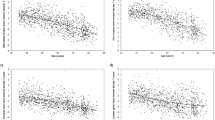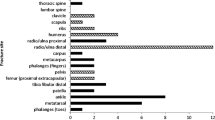Abstract:
Digital X-ray radiogrammetry (DXR) is a technique that uses automated image analysis of standard hand radiographs to estimate bone mineral density (DXR-BMD). Previous studies have shown that DXR-BMD measurements have high precision, are strongly correlated with forearm BMD and are lower in individuals with prevalent fractures. To determine whether DXR-BMD measurements predict wrist, hip and vertebral fracture risk we conducted a case–cohort study within a prospective study of 9704 community-dwelling elderly women (the Study of Osteoporotic Fractures). We compared DXR-BMD, and BMD of the radius (proximal and distal), calcaneus, femoral neck and posteroanterior lumbar spine in women who subsequently suffered a wrist (n= 192), hip (n= 195), or vertebral fracture (n= 193) with randomly selected controls from the same cohort (n= 392–398). DXR-BMD was estimated from hand radiographs acquired at the baseline visit. The radiographs were digitized and the Pronosco X-posure System was used to compute DXR-BMD from the second through fourth metacarpals. Wrist fractures were confirmed by radiographic reports and hip fractures were confirmed by radiographs. Vertebral fractures were defined using morphometric analysis of lateral spine radiographs acquired at baseline and an average of 3.7 years later. Age-adjusted odds ratio (OR, vertebral fracture) or relative hazard (RH, wrist and hip fracture) for a 1 SD decrease in BMD were computed. All BMD measurements were similar for prediction of wrist (RH = 1.5–2.1) and vertebral fracture (OR = 1.8–2.5). Femoral neck BMD best predicted hip fracture (RH = 3.0), while the relative hazards for all other BMD measurements were similar (RH = 1.5–1.9). These prospective data indicate that DXR-BMD performs as well as other peripheral BMD measurements for prediction of wrist, hip and vertebral fractures. Therefore, DXR-BMD may be useful for prediction of fracture risk in clinical settings where hip BMD is not available.
Similar content being viewed by others
Author information
Authors and Affiliations
Additional information
Received: 27 April 2001 / Accepted: 10 October 2001
Rights and permissions
About this article
Cite this article
Bouxsein, M., Palermo, L., Yeung, C. et al. Digital X-ray Radiogrammetry Predicts Hip, Wrist and Vertebral Fracture Risk in Elderly Women: A Prospective Analysis from the Study of Osteoporotic Fractures . Osteoporos Int 13, 358–365 (2002). https://doi.org/10.1007/s001980200040
Issue Date:
DOI: https://doi.org/10.1007/s001980200040




